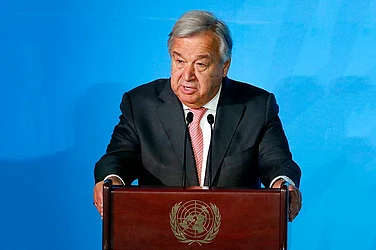The British monarchy is like an elaborate magic show. It has authority though it has no real powers. It uses elaborate costumes and shiny jewels to distract. And like most successful magic tricks, it relies on its audience’s inherent beliefs and perceptions to succeed. A slight of hand in a palace of illusions. And at the heart of it is the master of illusions — the monarch. And the monarch is immortal.
The passing of the 96-year-old Queen Elizabeth II, the longest reigning monarch of the United Kingdom, marks the end of an era for the nation, which has changed drastically in her 70 years of reign. So has the monarchy. It was under Elizabeth II that the monarchy saw its first divorce (and now first divorced Queen consort). It was Elizabeth II who as the formal head of the Church of England obliged the clergy to adopt a more tolerant and accepting attitude for non-Christian faiths. It was Elizabeth II who reportedly faced the quiet anger of her grandmother for showing up in a skirt at her father’s funeral. It was also Elizabeth II who allowed her coronation to be the first to be televised to mass audiences, broadcasting her solemn, divinely ordained right to the country for all to see. Visuals of the coronation, which was reportedly telecast against the Crown’s wishes, left millions spellbound and yet somehow intimately became part of her life. But a life on display is perhaps what she had prepared for all her life.
In the 19th century, German philosophers came up with the notion of Gesamtkunstwerk — a total work of art. This was any work of art that could synthesise numerous art forms to create one. The Gesamtkunstwerk takes place in grand settings that befits the spectacle. Both the performance of the spectacle and its implication is layered. In a paper titled The Synthesis of the Arts: From Ceremonial Ritual to “Total Work of Art”, Steven Brown and Ellen Dissanayake write that “total work of art is not merely a synthesis of artistic media per se, but is often times a form of mass spectacle that engenders total immersion, social collectivity, and even spiritual redemption by those who experience it”. In that sense, the monarchy can be seen as the spectacle and the monarch as the person in charge of running the show.
Not only was Elizabeth II destined from birth to be the face of one of the world’s most powerful empires in the world, she was a powerful cultural symbol of a bygone morality and nostalgia that worked wonders to disguise a political system of world domination that, in large parts, thrived on imposed inequality and oppression. Everything, from what she wore to how much she spoke, what she ate to how she raised her children, was the culmination of generations of royal diktats — a performance intended to play on people’s minds, sometimes to conjure support for shaky decisions, sometimes to hide past misdemeanours.
Much like in a magic show, belief is the key word. The monarchy is not only unpopular among its former colonies. Large sections of British politicians, citizens and media have time and again question the legitimacy of the monarchy, and its exorbitant ways. But the monarchy does not derive legitimacy from both function and action.
Bogged down by two consecutive wars, mass death and destruction and the shrinking sphere of British influence, many in post-War Britain blamed the wastrel and promiscuous ways of the hedonistic male monarchs. But there was also sympathy for the monarchy and belief in its divine rights. Though the tragic circumstances of Elizabeth’s ascension at the age of 25 led to a public rhetoric that favoured her, the Queen still had work to do. One of the first things on her agenda was to make people believe again.
She did so by restoring the faith of the British population in the “royal family” — a symbol of grace, tradition and pride in everything that Britain represented in its glory days. It became a moral benchmark, something to aspire to and inspire with. As the world eventually saw, this came at a great personal cost to some members of the royal family. Royal scandals are not unfamiliar and there have been many in the British monarchy. The rules and regulations imposed on the family were seen as a way to maintain purity and accountability and become role models that the country could look up to in times of crisis or wavering faith.
Though herself a champion of stoic family values, with time Queen Elizabeth’s reign nevertheless saw the monarchy take begrudging yet affirmative steps toward abolishing social ills like stigma against divorce, which was not permitted by the Church at the time. The Divorce Reform Act of 1969 was only a result of changing post-War attitudes toward sex and morality but also perhaps of the rising number of scandals involving royals and married women. As the troubled relationship between her son Charles and his wife Diana over his years-long extramarital affair with Camilla Parker also became public news fodder, reports suggest that the Queen made every effort to reach an amicable solution but later allowed the divorce of Charles and Diana against the Church rules, a first in the monarchy. She also allowed the marriage of Charles and Camilla, also a divorcee, after Diana’s death.
Beneath the veneer of royalty, it becomes hard to separate the sovereign from the mother, wife, daughter and sister. Yes, bits and pieces of the Elizabeth’s life are repeated as trivia at dinner tables — she holds a Guinness World Record for once being on the banknotes of 33 different currencies, she along with her sister Margaret bred Corgis and Dachshunds together to create the ‘Dorgi’. She wore different handbags to signify different occasions and political meanings. The list of curiosities and factoids about the royal are endless. And the monarch has done well to not reveal her true self from the prying eyes of the plebeians, hiding behind her bouncy hats and her stoic poker face.
The fact that that monarchy has lived on and will do so for at least a few more years if not forever is perhaps a vindication of the words of the 17th century English political philosopher Thomas Hobbes who asserted that there could be no society in the absence of a sovereign power that stands above individuals to “over-awe them all”. He also believed the society which represents “peaceable, sociable and comfortable living” was precariously perched on a “social contract” between the subjects and the sovereign in the absence of which life in general would reduce to being “solitary, poor, nasty, brutish, and short”.
A life of playing the ritual role in the world’s biggest play also cost the Queen some personal battles. A sovereign is omniscient and exceeds any other social obligation. It is believed that Elizabeth’s ascent to the throne put years of stress on her married life with Prince Phillip, who reportedly remained acrimonious for years before resigning to his fate. Much like Elizabeth, he too played his role to the T and if there were cracks, the couple never let it show. Elizabeth’s relationship with her sister Mary has also been the talk of town in past years. Her relationship with her four children was also complex.
But British queens have a history of putting the nation over family first. Early on in her reign, Queen Elizabeth I had proclaimed that she would not marry because she was 'already bound unto a husband which is the Kingdom of England'. She never did end up marrying and though her real reasons remain buried with her in her grave, the most believed idea is that she never married to protect England’s security by preventing any foreign powers to enter the British monarchy.
The last Queen, as the commander of the ritual perforce of aristocracy and monarchy, worked hard to maintain the veneer of a fading era and virtues that have long been questioned by the rest of the world. In later years, however, the magic started to wane. While much of the UK remains blissfully unaware of its own transgresses, the world, especially Britain’s former colonies, have been growing increasingly agitate of the monarchy’s surprising refusal to accept past follies. The fact that Kohinoor was a top trend on South Asian social media was not mere surprise.
While British school textbooks refrain from mentioning the dark stories of the Empire’s colonial chapters, the developing world is growing more vocal and many feel the need for at least a formal apology and acknowledgement. The giving back of the Kohinoor is symbolic. But Queen Elizabeth II knew the power of symbols, herself being one. And her failure to acknowledge the mistakes of her forefathers may outlive her decades of tireless work to preserve the illusion of the empire where the Sun never set.


























